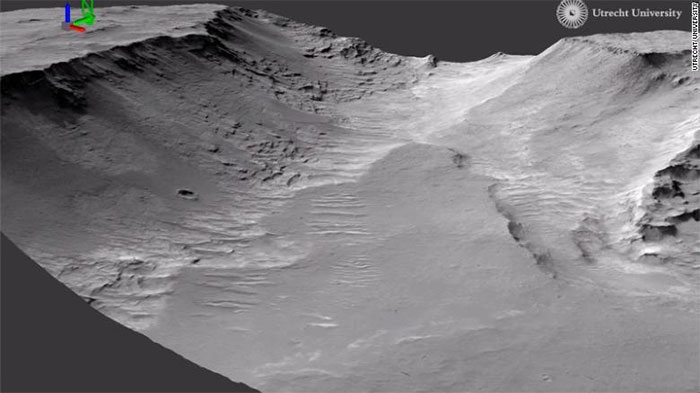Discover evidence of an ancient river on Mars
The characteristics of an age-old cliff on Mars led scientists to believe that this water once ran on the surface of the Red Planet billions of years ago.
According to research published May 5 in the journal Nature Communications, new images and data on exposed cliffs on Mars reveal the first evidence of rivers that have existed for more than 100,000 years on the surface of the planet. This planet was 3.7 billion years ago .
An international team of scientists has used the images captured by HiRISE cameras on probes orbit recorded on Mars to study a high cliff on the northwest edge of the Hellas impact basin at the southern hemisphere of Mars.

Ancient cliff on Mars. (Photo: NASA).
From the traces left on the cliff, they discovered evidence of a large lake, river, delta and canal. The rocks show that water has been a sustainable and significant presence on Mars in the past.
The researchers then narrowed their focus to a 200 m high cliff. The sedimentary rocks of this cliff are estimated to be about 3.7 billion years old. The deposits of sedimentary rock on this cliff are similar to what we observe during the formation of sedimentary rock on Earth as rivers flow through it. In order to form it, a stream needs to be there for a very long time.
"The rivers that formed these rocks may have been active for tens to hundreds of thousands of years," said Dr. Joel Davis, author of the analysis.
"High-resolution images allow us to" read "the rocks as if you were standing very close to the cliff," said Francesco Salese, co-author of the study, geologist at Utrecht University (Netherlands). ) for.
Salese and his colleagues believe the research is important because it helps shed light on the history of Mars, just like geologists use sedimentary layers on Earth to learn about Our planet's formation process billions of years ago.
- This is how humans can build life from nothing on Mars
- Discovered 2 ancient lakes under the surface of Mars
- The river is 1,500km long, once flowing on Mars
- Find out evidence of the ancient lake on Mars
- Important evidence shows that Mars is more likely to have life
- Discover more evidence of life on Mars
- Discover the best location to search for life on Mars
- Evidence of water once flowing on Mars
- Found new evidence of ancient oceans on Mars
- Evidence shows that Mars has life
- Mars used to be 'green planet' like Earth
- Reveal the living world on the 'dead planet'
- Aliens may have been on Mars 3.8 billion years ago
- Mars was once warm and rainy
 Announced 3 houses on the Moon and Mars
Announced 3 houses on the Moon and Mars Science proves: Mars also knows 'deflated'
Science proves: Mars also knows 'deflated' Elon Musk announced the price for a Mars trip was 11.6 billion VND, free of charge
Elon Musk announced the price for a Mars trip was 11.6 billion VND, free of charge NASA discovered strange 'gate' on Mars, is the hiding place found?
NASA discovered strange 'gate' on Mars, is the hiding place found?